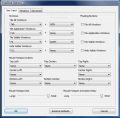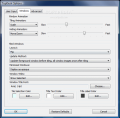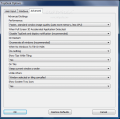How do you improve on Windows XP? Many will argue that it is the best OS Microsoft ever released. It is mature and all the users have gotten to know its deepest secrets, that's a fact. However, it has lots of flaws that are covered by third party applications. Judging by its looks, one can say that XP shows its age as there aren't any built-in eye-candies available.
But this can be changed with third party applications, some of them even freeware, like Vista Transformation Pack or Vistamizer. And if you spit a few bucks you can even get that nifty Aero look in Vista with WindowBlinds.
Speaking of Vista, I am sure you heard of Flip 3D, the three dimensional Alt+Tab alternative featured in elite Vista editions. Basic version does not sport it and only Home Premium, Business and Ultimate versions include it. However, there is a way to implement something very close to it in the Basic version and even in XP, as most computers running them are more than capable of supporting it.
The third party Flip 3D comes from Otaku Software, recent owner of DeskSpace (former Yod'm 3D). They call it TopDesk and priced it at $19.95. Besides the neat Flip 3D applied to toggling between opened windows the application is also mimicking Mac OS X's Expos? feature that allows easy switch between windows.
With a 14 days trial period of fully functional features, TopDesk installs in a jiffy (on both XP and Vista it took me about five seconds, on machines of average power). There is no interface but you get to make all sorts of settings. As soon as the installation is complete, a suite of three icons will be available in QuickLaunch (if you have it enabled). These are the shortcuts for flip tiling, spatial tiling and hiding of visible windows. The last one is actually more like docking them to the lower part of the screen.
Regarding the options, there aren't too many of them but those available will make the experience more comfortable. In the first tab of the Options panel the user can set the keyboard combinations for tiling the windows (all of them, active ones only, visible windows) or hiding them. To make tiling more accessible, TopDesk can enable floating buttons for all of these actions. These can be moved anywhere on the screen and have a certain level of transparency not to intrude.
A more efficient alternative to floating buttons and to QuickLaunch shortcuts are mouse hotspots that can be placed on the sides of your desktop (top, bottom, center on the left or right side). They are invisible and activate a user defined action at a simple hover of the mouse. You can also set the size of the hotspot and the activation delay by simply dragging the correspondent sliders from Large to Small and Long to Short, respectively.
Windows tab encloses settings for visual effects to be applied to the different actions. This is the place where you determine how TopDesk tiles and hides windows, and how tiled windows are displayed and updated. Tiling animation options permit scaling the windows first, rotating them on X,Y and Z axis and the speed of the action. For best visual effects, I suggest using scaling as it is the closest to Vista's Flip 3D.
Layout options practically define the way the windows are tiled. The three options let you choose between Flip, Grid and Spatial. The difference between Grid and Spatial may not be too obvious at the beginning, but it is there. While Spatial aligns the windows according to their on-screen position, Grid tiles them according to their position in the window Z-order.
The simple method by which TopDesk displays all the thumbs of the applications is simple. It just takes a snapshot of opened windows and puts them in different layouts. However, on less puissant computers it may take more time to capture and store window images and most of the times the images are not up-to-date. For best performance of your machine TopDesk makes available several image updating methods (eight of them to be exact) which assure the symbiotic relation between computer and application without hindering the performance of any of the two.
To make the difference between minimized windows and on-screen ones, TopDesk can render the former opaque or transparent. The application can also show the titles for all of the opened windows or only for the selected ones. The font and color of the title as well as the label and title selection can be tweaked for better view.
The last tab in Options panel deals with advanced settings meant to reach a good compromise between performance and image quality (memory used by TopDesk, speed of the application), enable/disable showing tips while tiling the windows as well as the way TopDesk should react when fullscreen 3D accelerated application is detected, what to do when there are no windows to deal with etc.
A very interesting option is configuring TopDesk to untile the windows when a certain action occurs. By default, you can use Windows key +Tab to tile them (flip spatial or grid), but when the keys are released tiling is still active. This enables you to use only Tab key to flip the windows. "Untile When" option lets you make the application act just like Flip 3D in Windows (untiling takes place when Win or Tab keys are released).
The application works seamlessly on both XP and Vista and the high level of configuration makes it worthy of your attention. It is flexible enough with enforcing the various actions available as there is a broad range of options to activate windows tiling.
The Good
Extremely easy to use, Otaku Software's TopDesk can be configured in terms of behavior, layout of the windows and performance with minimum effort from the user. You can disable it at any point and make it start with Windows for a more permanent use. To make it less intrusive, the tray icon can be hidden from view.
The Bad
The amount of resources used is quite something. About 30MB at all times plus CPU usage. So if your computer runs slow, you should know where to look first.
The price is a bit steep too, in my opinion. But hey, it's their product.
I wish the user could choose to arrange tiled windows the way s/he sees fit.
The Truth
TopDesk implements Premium Vista edition?s nifty features into XP and Vista Basic. It makes for a good Vista Flip 3D and Mac OS X Expos? substitute. Very easy to configure, the application has an excellent behavior even on average computers.
Here are some snapshots of the application in action:
 14 DAY TRIAL //
14 DAY TRIAL // 



